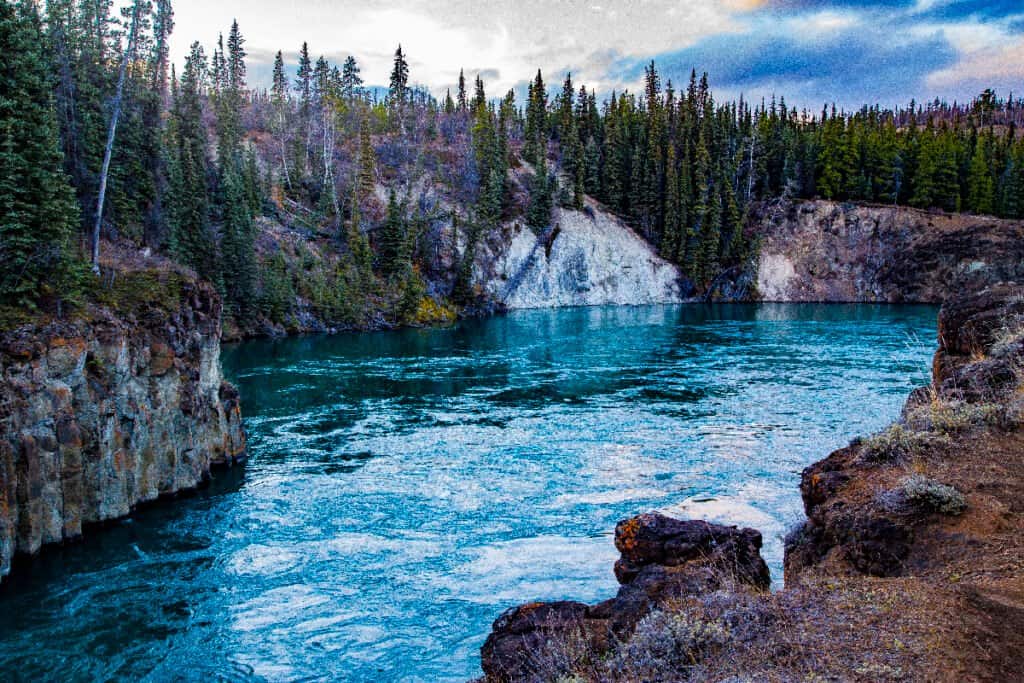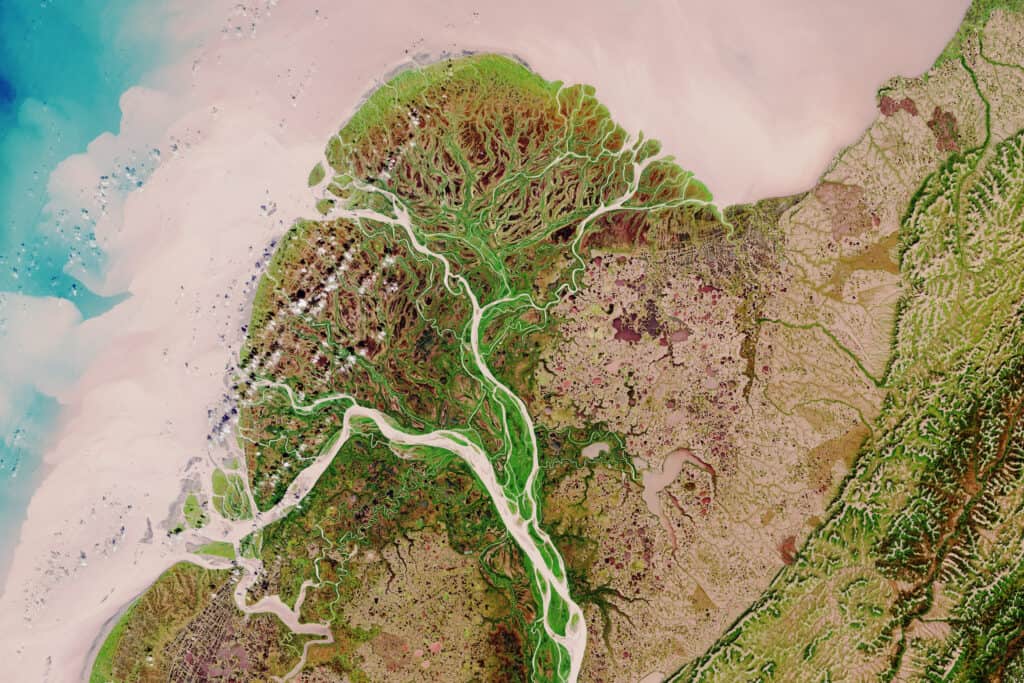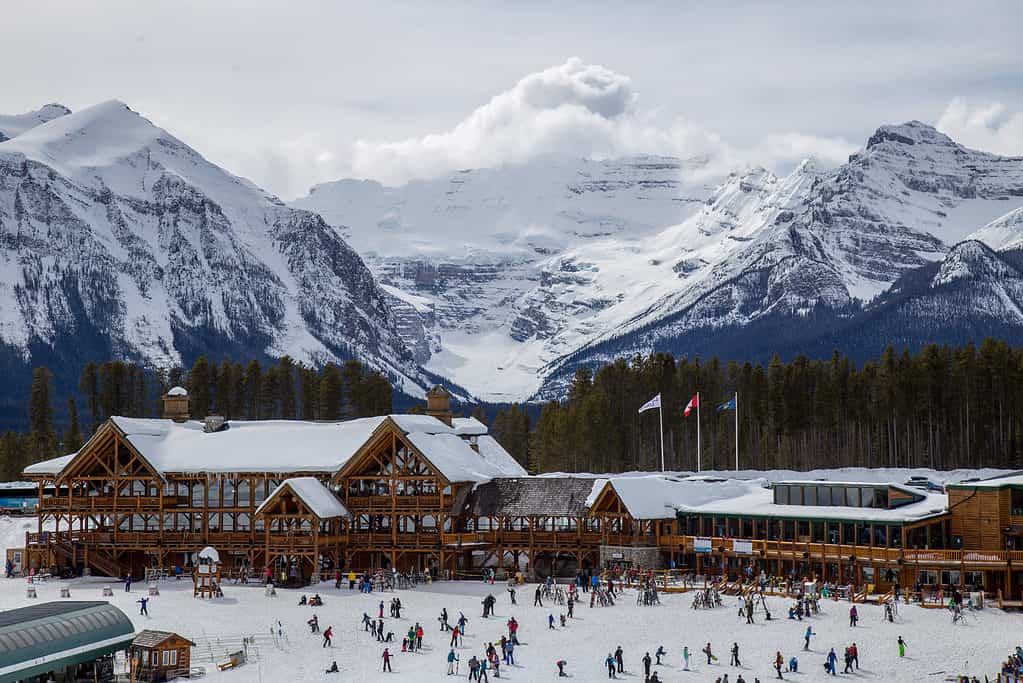Key Points:
- The Yukon River rises in northwestern British Columbia and ends in western Alaska at its confluence with the Pacific Ocean.
- In most spots, the river averages around 4-8 feet deep.
- At its deepest spot near Rampart, Alaska, the Yukon River measures approximately 130 feet deep.
The Yukon River begins in northwestern British Columbia. From there, the river runs through the Yukon and into Alaska before it reaches its terminus in the Pacific Ocean. It ranks as the longest river in Alaska and the Yukon and the 3rd longest river in North America by the main stem.
The Yukon River boasts an incredible amount of biological diversity. Along its banks, you can find a wide variety of animals, including beavers, otters, grizzly bears, deer, and elk. You can also find hundreds of different bird species and dozens of reptile and amphibian species. The river also supports various native and introduced fish species and hosts one of the longest salmon runs in the world.
Fishing in the Yukon River is a dream for many anglers. However, if you wish to fish on the river, you’ll need to know how deep it is. Keep reading to find out!
How Deep Is The Yellowstone River At Its Headwaters?

The Yukon River flows across the entire width of Alaska.
©iStock.com/HeatherECampbell
Most experts agree that the Llewellyn Glacier at the southern end of Atlin Lake is the source of the Yukon River. That said, some argue that the Yukon’s Rivers headwaters begin at Lake Lindeman. Either way, both lakes flow into Tagish Lake, which in turn flows into Marsh Lake, whose northern end acts as the start of the main stem of the Yukon River.
In most spots, the runoff from the Llewellyn Glacier measures no more than a few inches deep. However, this water collects into Atlin Lake, which measures nearly 948 feet deep at its deepest spot. Meanwhile, near the northern end of Marsh Lake, water levels average around 8 feet. When the Yukon River passes Whitehorse, the river is around 100 feet deep.
Can You Walk Across The Yukon River?
You can certainly walk across the Yukon River near its headwaters at Llewellyn Glacier. The runoff from the glacier measures just a few inches deep in most spots, so by forging these streams, you can technically say you’ve “walked across” the Yukon River. Additionally, you can wade across the river at several other locations. In many stretches, the river is only a few feet deep. This is especially true during the winter when the river’s water levels fall.
That said, many spots along the Yukon River are too deep to walk across. You would need to find a bridge or have a boat to cross many parts along the main stem of the Yukon River.
Where Is The Widest Spot Of The Yukon River?

The Yukon River river reaches its widest point in the height of summer.
©lavizzara/Shutterstock.com
The Yukon River varies in width depending on the spot and the time of year. Typically, the river reaches its widest point during the height of summer. Around this time, runoff from the nearby glaciers causes the river to swell and its water levels to rise. On average, the river measures anywhere from 400 to 1,500 feet wide. The river widens substantially between the towns of Rampart and Tanama. Along this stretch, the Yukon River averages around 2,690 feet wide. Meanwhile, the widest spot on the river is located near Pilot Station, Alaska. At this point, the Yukon River measures nearly 3,300 feet wide.
What Is The Average Depth Of The Yukon River?
As previously stated, the depth of the Yukon River varies according to the seasons and depending on the spot. However, the Yukon River is relatively shallow when looking at the river as a whole. In most spots, the river measures around 4 to 8 feet deep. Still, other parts of the river measure anywhere from 20 to 40 feet deep.
Where Is The Deepest Part Of The Yukon River?
You can find the deepest point on the Yukon River near the town of Rampart, Alaska. At this point, the Yukon River nears nearly 130 feet deep during the summer. A close runner-up for the deepest spot on the Yukon River resides near Whitehorse in the southern Yukon. The Canadian government operates several gaging stations along the Yukon River in the Yukon and British Columbia. Near Whitehorse, the Yukon River measures around 100 feet deep.
Where Is The Shallowest Part Of The Yukon River?

The Yukon River rises in northwestern British Columbia and ends in western Alaska at its confluence with the Pacific Ocean.
©CSNafzger/Shutterstock.com
The headwaters at the Llewellyn Glacier easily rank as the shallowest part of the Yukon River. In most spots, the runoff from the glacier measures no more than a few inches deep. However, several other spots on the river’s mainstem also measure quite shallow. For instance, near Dawson City in the Yukon, the Yukon River can get as low as 1 foot deep in some spots.
Where To Find The Yukon River On A Map
The Yukon River is one of the most significant geographical features in North America, spanning over 3,000 kilometers from its source in British Columbia all the way to its mouth at the Bering Sea. To locate it on a map, you can start by looking for western Canada and Alaska. The river originates in the Canadian province of British Columbia and flows northwest into Yukon Territory before crossing into Alaska, where it empties into the Bering Sea.
To be more specific, you can look for major cities along its length, such as Whitehorse (Yukon), Dawson City (Yukon), and Fairbanks (Alaska). Alternatively, search for landmarks such as Lake Laberge or Five Finger Rapids located along the route. One useful thing to note about locating rivers on a map is that they are typically shown with blue lines indicating their path through surrounding terrain.
How Long Is The Yukon River?
From its origins in British Columbia to its end in western Alaska, the Yukon River measures around 1,980 miles long. At that length, it easily ranks as the longest river in the Yukon and Alaska. Additionally, in terms of length, it matches up favorably with some of the longest rivers in North America. When considering main stems only, the Yukon River ranks as the 3rd longest river on the continent.
How Deep Is The Largest Lake Along The Yukon River?
The largest natural lake in British Columbia, Atlin Lake, is also one of the largest lakes on the Yukon River. This makes sense, given that its name in the Tlingit language literally translates to “big lake.” In total, Atlin Lake covers a total area of 305 square miles. Moreover, it ranks as one of the deepest lakes in North America. At its deepest point, Atlin Lake measures nearly 948 feet deep.
How Does The Yukon River’s Depth Compare To Other U.S. Rivers?
The Yukon River isn’t as deep as other rivers in the United States. For example, the Hudson River ranks the deepest in the U.S. At its deepest point, the Hudson River is 216 (or 203, depending on who you ask) feet deep. Moreover, it averages nearly 30 feet deep in most spots. The Mississippi and Missouri rivers are deeper on average than the Yukon rivers.
What Is The Deepest River In The World?
Formerly known as the Zaire River, the Congo River ranks as the 2nd longest river in Africa and the 9th longest river worldwide. It also holds the title of the deepest river in the world. The Congo River begins at Boyoma Falls and ends at its confluence with the Atlantic Ocean. At its deepest point, the Congo River is nearly 720 feet deep. That means it is over 5 times as deep as the deepest point on the Yukon River!
What Animals Live Around The Yukon River?

The Yukon River features many plants and animals, such as large mammals like moose.
©Patrick Herlihy/Shutterstock.com
The Yukon River is less biologically diverse than some rivers at lower latitudes. That said, it still features a wide variety of plants and animals. Along its banks, you can find large mammals like moose, grizzly bears, and wolves, as well as smaller creatures like beavers, otters, and bobcats. Many birds also live along or visit its waters, including grebes, herons, eagles, and ospreys. The river supports dozens of fish species, including 5 species of Pacific salmon. Here are some of the many fish you can find in the Yukon River:
- Chinook salmon
- Sockeye salmon
- Pink salmon
- Chum salmon
- Coho salmon
- Dolly Varden trout
- Rainbow trout
- Northern pike
- Burbot
- Sheefish
- Humpback whitefish
- Broad whitefish
- Bering cisco
- Arctic char
- Arctic grayling
What Sort Of Boats Can Fit Down The Yukon River?
Even though it is rather shallow, you can fit a wide variety of boats down the Yukon River. During the 18th and 19th centuries, paddle boats often traveled down the river. Today, many people travel the river via kayak, canoe, or motorboat.
Can You Travel The Entire Yukon River By Boat?
Depending on the time of year, you can travel the length of the Yukon River by boat. Although it features several rapids, the river is mostly unobstructed by dams or other obstacles. Additionally, the Yukon River is relatively shallow and slow-moving in most parts. This makes it relatively easy to travel by boat, as you don’t have to fight through swift currents. However, the river’s height drops significantly or freezes over during drier months or in winter. At those times, sections of the river become impassable by boat.
Summary Of The Depth Of The Yukon River
| Yukon River | |
|---|---|
| Average Depth | 4-8 feet |
| Deepest Point | 130 feet |
The photo featured at the top of this post is © iStock.com/HeatherECampbell
Thank you for reading! Have some feedback for us? Contact the AZ Animals editorial team.






